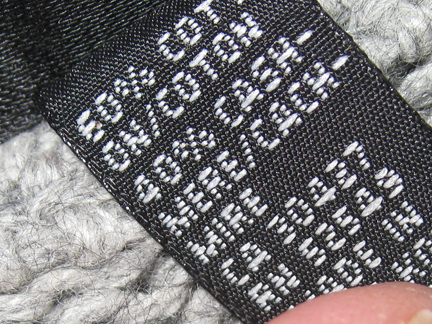"Anonymous" asked a good question, and I thought I'd answer it as a blog entry.
How do you know a sweater would be good to do this with? Where do you get the yarn-winder-thingy?Most straightforward one first: I got my yarn/ball-winder from joannfabrics.com. It's a Royal brand ball-winder - the first one shown (I don't know what the difference is between that and the second one shown). Saved my sanity more than once. (Some people very much enjoy winding balls by hand -- I am not one of them.) I think they're also available via Wal-mart, Michael's, etc. I used Joann's site because I had a 40%-off coupon. Coupons rule. (The other thing shown there is a swift, which also comes in handy.)
There are some good tutorials online -- here's one to get you started. If you're on Ravelry, there is a group called Thrifty Knitters that has a small collection of tutes listed - for recycling yarn, building your own swifts, etc. - as well as fairly regular discussion on the recycling. You can also enter yarn into your stash as "recycled," which I love.
How I look for sweaters to unravel:
I also look for sweaters to felt, but will not include info. about that, because it makes things a little too convoluted.
 My method is really not very scientific. I want to end up with colors I can use, fiber I like to knit with, and a reasonable gauge/weight. They're all sorted by color in most of the stores I go into, so I can skip the colors I don't like much if I'm in a hurry. Here's a typical process:
My method is really not very scientific. I want to end up with colors I can use, fiber I like to knit with, and a reasonable gauge/weight. They're all sorted by color in most of the stores I go into, so I can skip the colors I don't like much if I'm in a hurry. Here's a typical process:1. Run my hand along the sweaters in a particular color, pausing to feel the fabric. If it's not too pilly and appeals to me, I'll pull the collar back to check the fiber content.
100% wool may be good, if it's soft. Again, I want to end up with yarn I want to use. For knitting, I have no use for scratchy yarn. I usually skip 100% acrylic, preferring blends, but will consider 100% if it's a great color, soft and in good shape. I pray for something with merino wool, cashmere or silk in the blend.
2. Check the weight of the yarn. Look for stitch definition - if it's really thin, I don't bother with it. You can do really well with laceweights if you like that kind of thing, but I'm not into that now, so I look for at least DK weight yarns.
3. Check the seams. If they're serged together, it's out of the running for unraveling, because it's been cut to fit and is simply a series of short strings sewn together at the sides. If the seams are actually seamed (see the tute linked above), it's in the running for going home.
4. Check the price. Some of the thrift stores around here have crazy prices. I typically won't pay more than $4-$5 for a sweater; bonus if it's under $2 (I like to look for the tag color of week or day in the shops that have half-off specials).
Part two: Back at home, coming soon


No comments:
Post a Comment